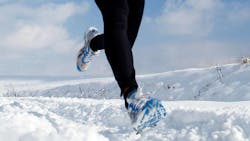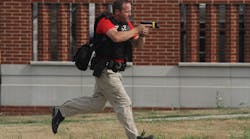As I’m writing this the outdoor temp is a balmy 4° F, and that is before factoring in the wind chills we who live tucked between several million acres of relatively flat prairie and the Great Lakes have become accustomed to! My walk loving dogs are actively strategizing how to avoid going outside ever again (as the world is surely coming to an end!), my personal motivation for physical activity has tanked, and several straight months of healthy eating and steady exercise are challenged by a vestigial drive to quickly fatten up and conserve energy in order to survive the winter.
Now, of course the 21st Century Me knows in my head I’ll be fine. A high efficiency home furnace, beefed up squad car engines (with correspondingly beefed up climate control), and an insistence on only top quality thermal gear for the cold months guarantees only the most temporary discomfort, and that really quite manageable; the part of me connected to generations of ancestors through the primitive collective memory evolutionarily encoded in my genes just isn’t so sure. And so I’m driven to hunker down, seek comfort, preserve precious energy stores, and wait for spring. The problem now, here in the 21st Century, is that primitive survival drive is actually very harmful.
Many of us struggle to maintain a healthy level of physical activity, and this is true for law enforcement officers. As we’ve written previously…
According to the Mayo Clinic, 50 – 70% of people spend 6 or more hours a day sitting. A sedentary lifestyle is measured by how long a person’s body stays at rest. Even if you routinely run 3 miles before each shift, but then spend the rest of the day sitting down with no further regular activity, you lead a sedentary lifestyle.
The costs of this sedentary lifestyle are significant: back (and hip, shoulder, and neck) pain; muscle atrophy, along with reduce muscular flexibility and efficiency; increased risk of diabetes, hypertension, cancer, circulation problems, sleep apnea, and thrombosis; decreased motivation and reduced mental acuity; increased risk of injury or even disability; and a lowered metabolism with unwanted weight gain.
Gains made from healthy activity – as well as good eating and positive mental energy – are easily lost when the days get colder and the nights grow longer, requiring a hard reboot when the bad weather breaks, if you are even able to restore healthy habits in the first place. Likewise, our brains are becoming equally sedentary, undoing good habits that may have taken many months to formulate (it takes 6 months to a year to rewire the brain into a new path of thinking… but not nearly so long to unravel the hardwiring).
As a reminder, we return to guidelines we’ve used before, but that serve all of us well to plan our fitness goals for when Mother Nature turns on us:
2008 Physical Activity Guidelines for Americans Summary
Key Guidelines for Adults
- All adults should avoid inactivity. Some physical activity is better than none, and adults who participate in any amount of physical activity gain some health benefits.
- For substantial health benefits, adults should do at least 150 minutes (2 hours and 30 minutes) a week of moderate-intensity, or 75 minutes (1 hour and 15 minutes) a week of vigorous-intensity aerobic physical activity, or an equivalent combination of moderate- and vigorous intensity aerobic activity. Aerobic activity should be performed in episodes of at least 10 minutes, and preferably, it should be spread throughout the week.
- For additional and more extensive health benefits, adults should increase their aerobic physical activity to 300 minutes (5 hours) a week of moderate intensity, or 150 minutes a week of vigorous intensity aerobic physical activity, or an equivalent combination of moderate- and vigorous-intensity activity. Additional health benefits are gained by engaging in physical activity beyond this amount.
- Adults should also do muscle-strengthening activities that are moderate or high intensity and involve all major muscle groups on 2 or more days a week, as these activities provide additional health benefits.
Investing in – and diligently using – high quality cold weather clothing makes outdoor time much more pleasant, including activities like running (which a lot of people enjoy much more in the winter than warmer months), cross country and downhill skiing, snowshoeing, or just walking for distances. Snow can add layers of resistance to hiking that offer great physical benefits. Winter is also a good time to invest in (or dust off) health club memberships, or to take up excellent mind/body workouts like yoga or Pilates, both of which have proven strength, stamina, flexibility, and mindfulness benefits.
And of course, frequent and varied physical activity is better than a few episodes of concentrated exercise. A lot of us figure an hour or two of a vigorous workout each day suffices to forgive being sedentary the rest of the day. Unfortunately, a growing body of research is revealing that the inactivity following even a great workout may undo or negate most of its benefits. Getting up and moving for even a few minutes every hour or so or periodically taking time to stretch throughout the day will bolster and support your more concerted exercise efforts.
Staying active pays off; inactivity takes a significant toll on the body. The human body, for optimal health and efficiency, needs to move, and probably a lot more than we are doing. Finding creative ways to increase your daily, weekly, and monthly activity when our instincts tell us to hunker down will keep your health goals on track.



